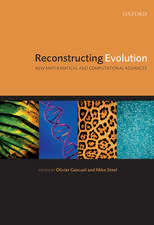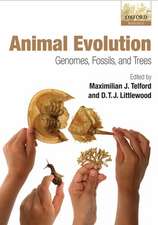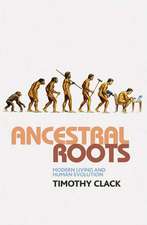The Statistics of Natural Selection on Animal Populations: Molecular Biology Intelligence Unit
Autor Brian F. Manlyen Limba Engleză Paperback – 8 noi 2013
Din seria Molecular Biology Intelligence Unit
- 5%
 Preț: 663.61 lei
Preț: 663.61 lei - 18%
 Preț: 1229.10 lei
Preț: 1229.10 lei - 5%
 Preț: 1091.14 lei
Preț: 1091.14 lei - 24%
 Preț: 776.00 lei
Preț: 776.00 lei - 18%
 Preț: 1226.60 lei
Preț: 1226.60 lei - 15%
 Preț: 642.51 lei
Preț: 642.51 lei - 5%
 Preț: 1098.48 lei
Preț: 1098.48 lei - 15%
 Preț: 638.11 lei
Preț: 638.11 lei - 18%
 Preț: 944.99 lei
Preț: 944.99 lei - 5%
 Preț: 716.09 lei
Preț: 716.09 lei - 20%
 Preț: 552.99 lei
Preț: 552.99 lei - 5%
 Preț: 1096.62 lei
Preț: 1096.62 lei - 5%
 Preț: 1097.71 lei
Preț: 1097.71 lei - 18%
 Preț: 942.94 lei
Preț: 942.94 lei - 18%
 Preț: 1222.49 lei
Preț: 1222.49 lei - 5%
 Preț: 1408.97 lei
Preț: 1408.97 lei - 18%
 Preț: 947.04 lei
Preț: 947.04 lei - 5%
 Preț: 1094.60 lei
Preț: 1094.60 lei - 18%
 Preț: 945.79 lei
Preț: 945.79 lei - 24%
 Preț: 1053.41 lei
Preț: 1053.41 lei - 24%
 Preț: 786.20 lei
Preț: 786.20 lei - 24%
 Preț: 789.90 lei
Preț: 789.90 lei - 18%
 Preț: 945.62 lei
Preț: 945.62 lei - 5%
 Preț: 1095.90 lei
Preț: 1095.90 lei - 5%
 Preț: 1429.27 lei
Preț: 1429.27 lei - 24%
 Preț: 817.72 lei
Preț: 817.72 lei - 5%
 Preț: 1104.84 lei
Preț: 1104.84 lei - 18%
 Preț: 947.85 lei
Preț: 947.85 lei - 15%
 Preț: 640.88 lei
Preț: 640.88 lei - 18%
 Preț: 951.29 lei
Preț: 951.29 lei - 5%
 Preț: 1095.73 lei
Preț: 1095.73 lei - 18%
 Preț: 950.33 lei
Preț: 950.33 lei - 18%
 Preț: 946.55 lei
Preț: 946.55 lei - 18%
 Preț: 952.89 lei
Preț: 952.89 lei - 5%
 Preț: 714.63 lei
Preț: 714.63 lei - 18%
 Preț: 946.41 lei
Preț: 946.41 lei - 18%
 Preț: 947.85 lei
Preț: 947.85 lei - 18%
 Preț: 956.03 lei
Preț: 956.03 lei - 5%
 Preț: 1293.05 lei
Preț: 1293.05 lei - 5%
 Preț: 1098.63 lei
Preț: 1098.63 lei - 18%
 Preț: 944.19 lei
Preț: 944.19 lei - 18%
 Preț: 950.52 lei
Preț: 950.52 lei - 24%
 Preț: 782.72 lei
Preț: 782.72 lei - 18%
 Preț: 953.65 lei
Preț: 953.65 lei - 15%
 Preț: 640.06 lei
Preț: 640.06 lei - 5%
 Preț: 1610.67 lei
Preț: 1610.67 lei - 18%
 Preț: 947.35 lei
Preț: 947.35 lei - 18%
 Preț: 1231.32 lei
Preț: 1231.32 lei - 15%
 Preț: 649.06 lei
Preț: 649.06 lei - 18%
 Preț: 1231.16 lei
Preț: 1231.16 lei
Preț: 400.10 lei
Nou
Puncte Express: 600
Preț estimativ în valută:
76.58€ • 83.21$ • 64.37£
76.58€ • 83.21$ • 64.37£
Carte tipărită la comandă
Livrare economică 21 aprilie-05 mai
Preluare comenzi: 021 569.72.76
Specificații
ISBN-13: 9789401086462
ISBN-10: 940108646X
Pagini: 504
Ilustrații: XVI, 484 p.
Dimensiuni: 155 x 235 x 26 mm
Greutate: 0.7 kg
Ediția:Softcover reprint of the original 1st ed. 1985
Editura: SPRINGER NETHERLANDS
Colecția Springer
Seria Molecular Biology Intelligence Unit
Locul publicării:Dordrecht, Netherlands
ISBN-10: 940108646X
Pagini: 504
Ilustrații: XVI, 484 p.
Dimensiuni: 155 x 235 x 26 mm
Greutate: 0.7 kg
Ediția:Softcover reprint of the original 1st ed. 1985
Editura: SPRINGER NETHERLANDS
Colecția Springer
Seria Molecular Biology Intelligence Unit
Locul publicării:Dordrecht, Netherlands
Public țintă
ResearchCuprins
1 The study of evidence for natural selection.- 2 Mark&—recapture experiments.- 3 Samples taken from a population within one generation.- 4 Comparison of live and dead animals.- 5 Complete counts of survivors.- 6 Evidence from the spatial distribution of a population.- 7 Association between related species.- 8 Gene frequency changes at a single genetic locus.- 9 Equilibrium gene frequencies at a single locus.- 10 Linkage disequilibrium and selection at two or more loci.- 11 Selection on quantitative variables.- 12 Further analyses using genetic data.- 13 Non-random mating and sexual selection.- 14 Concluding remarks.- Statistical appendix.- References.- Name Index.
















